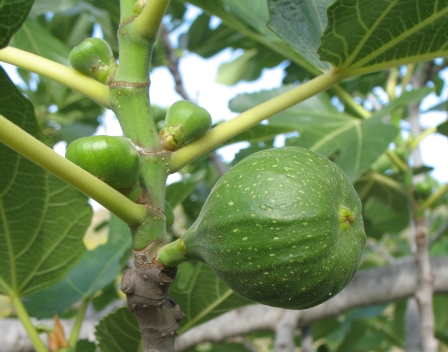
To listen to today’s reflection as a podcast, click here
Every day during this season of Lent we’re looking at the miracles of Jesus – his spectacular displays of supernatural power that are reported in the Gospels.
Americans are big fans of fruit.
Bananas are far and away the national favorite, appearing on the kitchen counters of some 83% of households. Apples, grapes, strawberries, and melons round out the top five.
Then come avocadoes, blueberries, oranges, pineapples, raspberries, peaches, lemons, limes, kiwis, and grapefruit. Mangoes come in at #20 on the most popular list, going home with 9% of shoppers.
How about figs? As the host of Family Feud might say, figs did not make our survey.
It didn’t use to be that way. Back in the 19th century, doctors believed that most illnesses were associated with poor digestion. The proposed remedy was a combination of fruit and dough, which in 1891 led an entrepreneur named Charles Rosen to conjure up an exceedingly popular “fig paste roll” that he named after the town of Newton, Massachusetts – hence the birth of fig Newtons. Since 2012, they’ve been marketed by Nabisco simply as Newtons.
Figs have long been a staple in the diet of Middle Easterners. The good life, according to the Old Testament prophets, is that “every man shall sit under his grapevine or fig tree with no one to disturb him”
(Micah 4:4).
The fig tree even became symbolic of the nation of Israel. “When I found Israel, it was like finding grapes in the desert. When I saw your fathers, it was like seeing the early fruit on the fig tree” (Hosea 9:11).
That provides the background to one of the most startling of Jesus’ miracles.
After the triumphal entry into Jerusalem in the presence of a palm-waving crowd, Jesus and his disciples retreat to the village of Bethany, where they spend the night. The events of the next day unfold in Matthew 21:18-19:
Early in the morning, as Jesus was on his way back to the city, he was hungry. Seeing a fig tree by the road, he went up to it but found nothing on it except leaves. Then he said to it, “May you never bear fruit again!” Immediately the tree withered.
In his telling of the same story, Mark reports, “[Jesus] found nothing but leaves, because it was not the season for figs” (Mark 11:13). So what in the world does Jesus expect? Why is he so unrealistically irritated?
Before we accuse the Son of God of botanicide, however, we should enroll ourselves in Figs 101.
Fig trees are deciduous. They drop their leaves in the fall. They “green up” again in the spring and produce their primary crop of fruit late in the summer.
Just as the leaves begin to appear in the spring, however, trees often produce what are called “early” or “preseason figs,” like the ones in the picture above. In Hebrew these are known as page (pronounced pa-geh). This accounts for the name of the small village not far from Bethany called Bethphage. While English transliteration generally leads us to mangle the town’s pronunciation, in Hebrew it is Beth-page, or “House of Early Figs.” This was clearly an area known for trees that produced preseason fruits.
Page are not nearly as delicious as late summer figs. But they do provide nourishment and refreshment. Notice again that text from Hosea: “When I saw your fathers, it was like seeing the early fruit on the fig tree.” In other words, when Israel was at its best, the result was similar to the joy and relief of discovering a tree with page. God was providing for his people.
This accounts for Jesus’ dramatic response to one particular fig tree.
This tree, for want of a better word, is “hypocritical.” Its leaves are green. But there is no fruit. It is advertising fruitfulness but failing to deliver.
That’s exactly what the disciples will discover in Jerusalem during this last week of Jesus’ life. The temple leaders are hypocrites. They claim to represent God. But their actions – the absence of spiritual fruit in their lives – makes it clear that they have neither the capacity nor the desire to walk their talk. They are defrauding the poor in the very courts of the Lord.
And that infuriates Jesus. By pronouncing judgment on the fig tree – symbolic of the nation of Israel – Jesus is expressing divine righteous anger.
Does this mean that we, as followers of Jesus, also need to “get mad” in order to accomplish God’s work in a broken world?
Earlier this month pastor David Williamson, in writing about Jesus and the fig tree, made these observations:
“There are things within this world that should fill us with such righteous anger—a ‘holy discontent’ with the way the world works, or a deep and abiding passion for a group of people who have been wronged. We sometimes ignore or suppress those feelings… To the far extreme, we can also let our discontent fester into a poisonous rage, stealing away any sense of joy and hope in our lives. Somewhere between ‘apathy’ and ‘anger,’ though, is a sweet spot where our discontent moves us into purposeful and hopeful action.”
Bob Pierce, the founder of World Vision, repeated the same prayerful mantra his entire adult life: “Let my heart be broken with the things that break the heart of God.”
How do we discern such things?
We study the life of Jesus. We pay attention to what moves him, what exasperates him, what delights him. We pray. We ask for the chance to make a difference in this world, and we look for the doors of opportunity that God is always opening.
Then we step out with the courage and strength that are provided by the Holy Spirit who lives within us.
And maybe, just maybe, as a reminder, we always keep a bag of Newtons
